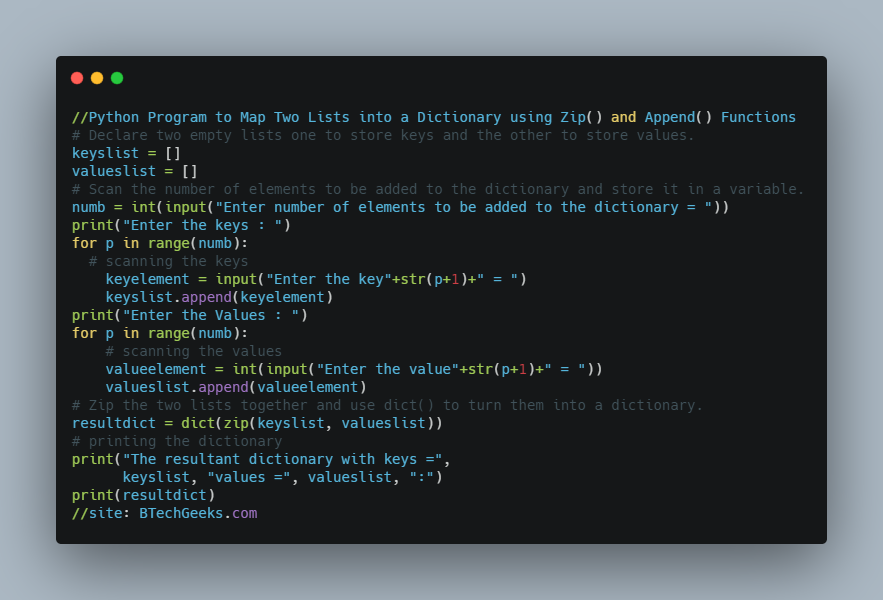Our website provided core java programs examples with output aid beginners and expert coders to test their knowledge gap and learn accordingly.
Dictionaries in Python: In Python, a dictionary dict is a one-to-one mapping; it includes a set of (key, value) pairs, with each key mapped to a value. It exemplifies a hash map or hash table (from Computer Science). Each key denotes a value and is separated by a colon (:).
Curly brackets are used to define a dictionary. The value to the left of the colon is known as the key, while the value to the right of the colon is known as the value. A comma separates each (key, value) pair.
- Python Programming Examples on How to Map Two Lists into a Dictionary
- Python Program to Map Two Lists into a Dictionary
- Write a Python Program to Map Two Lists into a Dictionary?
- How to Combine Two Lists into a Dictionary Python?
- Python Program to Map Two lists into a Dictionary using Dictionary Comprehension
- How to Combine Two List and Convert into Dictionary using For Loop?
Python Programming Examples on How to Map Two Lists into a Dictionary
Example 1:
Input:
Enter number of elements to be added to the dictionary = 8 Enter the keys : Enter the key1 = hello Enter the key2 = this Enter the key3 = is Enter the key4 = btechgeeks Enter the key5 = online Enter the key6 = coding Enter the key7 = python Enter the key8 = platform Enter the Values : Enter the value1 = 45 Enter the value2 = 82 Enter the value3 = 125 Enter the value4 = 962 Enter the value5 = 712 Enter the value6 = 100 Enter the value7 = 852 Enter the value8 = 965
Output:
The resultant dictionary with keys = ['hello', 'this', 'is', 'btechgeeks', 'online', 'coding', 'python', 'platform']
values = [45, 82, 125, 962, 712, 100, 852, 965] :
{'hello': 45, 'this': 82, 'is': 125, 'btechgeeks': 962, 'online': 712, 'coding': 100, 'python': 852, 'platform': 965}
Example 2:
Input:
Enter number of elements to be added to the dictionary = 5 Enter the keys : Enter the key1 = good Enter the key2 = morning Enter the key3 = python Enter the key4 = script Enter the key5 = code Enter the Values : Enter the value1 = 745 Enter the value2 = 123 Enter the value3 = 985 Enter the value4 = 100 Enter the value5 = 585
Output:
The resultant dictionary with keys = ['good', 'morning', 'python', 'script', 'code']
values = [745, 123, 985, 100, 585] :
{'good': 745, 'morning': 123, 'python': 985, 'script': 100, 'code': 585}
Python Program to Map Two Lists into a Dictionary
Mapping Two Lists into a Dictionary using zip() ,append() Functions
Approach:
- Declare two empty lists one to store keys and the other to store values.
- Consider using a for loop to accept values for both lists.
- Scan the number of elements to be added to the dictionary and store it in a variable.
- Scan the values into the list and insert them into the list using another for loop.
- Repeat steps 4 and 5 for the values list as well.
- Zip the two lists together and use dict() to turn them into a dictionary.
- Print the dictionary.
- Exit of program.
Write a Python Program to Map Two Lists into a Dictionary?
# Declare two empty lists one to store keys and the other to store values.
keyslist = []
valueslist = []
# Scan the number of elements to be added to the dictionary and store it in a variable.
numb = int(input("Enter number of elements to be added to the dictionary = "))
print("Enter the keys : ")
for p in range(numb):
# scanning the keys
keyelement = input("Enter the key"+str(p+1)+" = ")
keyslist.append(keyelement)
print("Enter the Values : ")
for p in range(numb):
# scanning the values
valueelement = int(input("Enter the value"+str(p+1)+" = "))
valueslist.append(valueelement)
# Zip the two lists together and use dict() to turn them into a dictionary.
resultdict = dict(zip(keyslist, valueslist))
# printing the dictionary
print("The resultant dictionary with keys =",
keyslist, "values =", valueslist, ":")
print(resultdict)

Output:
Enter number of elements to be added to the dictionary = 8
Enter the keys :
Enter the key1 = hello
Enter the key2 = this
Enter the key3 = is
Enter the key4 = btechgeeks
Enter the key5 = online
Enter the key6 = coding
Enter the key7 = python
Enter the key8 = platform
Enter the Values :
Enter the value1 = 45
Enter the value2 = 82
Enter the value3 = 125
Enter the value4 = 962
Enter the value5 = 712
Enter the value6 = 100
Enter the value7 = 852
Enter the value8 = 965
The resultant dictionary with keys = ['hello', 'this', 'is', 'btechgeeks', 'online', 'coding', 'python', 'platform'] values = [45, 82, 125, 962, 712, 100, 852, 965] :
{'hello': 45, 'this': 82, 'is': 125, 'btechgeeks': 962, 'online': 712, 'coding': 100, 'python': 852, 'platform': 965}
How to Combine Two Lists into a Dictionary Python?
- The number of elements in the list must be entered by the user and saved in a variable.
- The user must assign values to the equal number of entries in the list.
- The append function takes each element from the user and appends it to the end of the list as many times as the number of elements taken is.
- The identical steps as in 2 and 3 are taken for the second value list.
- The zip() function is used to combine the two lists.
- Using dict, the zipped lists are then combined to make a dictionary ().
- The dictionary created by combining the two lists is then printed.
Python Program to Map Two lists into a Dictionary using Dictionary Comprehension
Dictionary Comprehension is a technique used to create a dictionary in Python. In this process, we will combine two sets of data either in lists or arrays. It is a simple approach for creating dictionaries and uses pointed brackets({}).
items = ['book', 'pen', 'paper']
quantities = [5, 10, 25]
items_dict = {key:value for key, value in zip(items, quantities)}
print(items_dict)
Output:
{'book': 5, 'pen': 10, 'paper': 25}
How to Combine Two List and Convert into Dictionary using For Loop?
fruits = ['Orange', 'Pomegranate', 'Banana','Guava']
price = [80, 70, 112, 66]
fruits_price = zip(fruits, price)
# create dictionary
fruits_dict = {}
for key, value in fruits_price:
if key in fruits_dict:
# handling duplicate keys
pass
else:
fruits_dict[key] = value
print(fruits_dict)
Output:
{'Orange': 80, 'Pomegranate': 70, 'Banana': 112, 'Guava': 66}
Related Programs:
-
- Python Program to Count the Frequency of Words Appearing in a String Using a Dictionary
- Python Program to Iterate Through Two Lists in Parallel
- Python Program to Generate a Dictionary that Contains Numbers (between 1 and n) in the Form (x, x*x).
- Python Program to Add a Key, Value Pair to the Dictionary
- Python Program to Sum All the Items in a Dictionary
